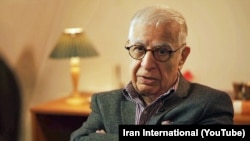Radiofarda – In a series called “Forty Years, Forty Interviews,” Radio Farda’s Farhang Ghavimi is sitting down with 40 prominent Iranians who played a role in events leading up to the Islamic Revolution 40 years ago. In a recent episode he spoke with Amir Taheri, who was then the Editor-in-Chief of the Iranian mass-circulation daily Kayhan.
Now considered one of the most conservative newspapers in Iran, prior to the 1979 Iranian Revolution when Taheri was at the helm, Kayhan had a much broader readership. Taheri made a key decision not to print a letter believed to be from the court of Shah Mohammad Reza Pahlavi, harshly attacking an almost forgotten exiled Iranian dissident cleric, Ayatollah Ruhollah Khomeini.
Another newspaper did print the vitriolic letter, titled “Iran and the Black and Red Imperialism,” which called Khomeini an “Indian” cleric on the payroll of Egypt’s authoritarian leader Gamal Abdel Nasser.
Taheri says the letter’s publication had the opposite of its intended effect, drawing attention to Khomeini and winning him sympathy among Iranians already dissatisfied with the Shah, paving the way for the Iranian Revolution and Khomeini’s rise to power.
“I read it and found it insulting, as well as against our style and mission statement,” Taheri remembers. “I contacted several top authorities who, either sincerely or deceptively, said they didn’t know where the letter came from.”
To this day, the real author of the letter or who and for what reason it was given to two mass circulation dailies by a senior official remain a mystery.
The publication of the letter under the pseudonym Ahmad Rashidi Motlaq (or Motlagh) in the newspaper Ettelaat led to protest rallies that soon gained momentum and spread to most urban areas in Iran.
The next crucial event, according to Taheri, happened on August 19, 1978, when the Cinema Rex movie theater in the city of Abadan in the oil-rich province of Khuzestan, southwest Iran, was deliberately set ablaze, killing at least 420 people.
The government initially blamed “Islamic Marxists” from the dissident armed group Mojahedin Khalq Organization (MKO) for the massacre. The anti-monarchy and Islamic revolutionary forces, for their part, accused the Shah’s intelligence service, the SAVAK, of setting the deadly blaze to discredit the revolutionaries loyal to the exiled Ayatollah Khomeini.
“Our reaction was the same as everybody else’s across the country,” said Taheri. “We were deeply shocked, really saddened, and worried about the future. Iranians were not used to killing each other. We had not experienced such disastrous events before.”
Taheri says he and other journalists at the paper were in regular contact with the revolutionaries and believed such a barbaric act to be out of character for them. On the other hand, he says, the SAVAK did not have a record of carrying out such carnage either and were mainly tasked with combatting communism. A third theory, Taheri argues, points to unorganized, rogue Islamic militants, who were known to set fires to banks and drinking establishments.
The Iranian major dailies, specifically Kayhan, were accused at the time of being infiltrated by anti-Shah revolutionaries. Amir Taheri dismisses the claim, insisting, “In Kayhan, as in the other media across the world, there were anti-ruling establishment elements. Anti-system journalists are present everywhere, including in the UK, U.S., or France. Therefore, Kayhan was not an exception, especially if you remember that the journalists working for Kayhan were mainly young. And the young ones, as you know, tend to be rebellious. Conservatism comes by aging.”
While admitting that there were pro-revolutionary elements working at Kayhan, Amir Taheri reiterates that they used to work alongside pro-monarchy journalists, but their political tendencies did not have an impact on the paper’s editorial policy.
“In my ten or eleven years of serving as a journalist, I had only met Shah Mohammad Reza Pahlavi a couple of times, but, during the last days of his rule, I saw him more,” Taheri remembers. “I found him a broken, decrepit man, taking so many pills. He was deeply brokenhearted.”
Taheri says he soon realized their meetings were more like therapy for the Shah and that nothing journalistic would come of them.
“His Majesty only wanted to talk with somebody, even with a piece of wood. He repeatedly asked, ‘How come the people hate me so much, after all the things I did for them?’”
According to Taheri, the Shah deplored the staged pro-monarchy demonstrations put on by his close allies.
Taheri believes that the Iranian ruling establishment under the Shah had the necessary mechanism for reform and avoiding a revolution, “But, the head of the system was sick, and the political staff needed for reform were missing. Therefore, relevant reforms did not happen in Iran, while they did in South Korea as well as in many Eastern European countries.”
Taheri insists that Iran needed reform, not a revolution. He blames Iranian intellectuals on both the right and left for the revolution.
“Being against the Shah and his government was simply the order of the day,” he said.
Amir Taheri was the editor-in-chief of the daily Kayhan in Iran from 1972 to 1979. He has written for The Washington Post, The Wall Street Journal, The New York Post, as well as published eleven books. In 2012 he was named International Journalist of the Year by the British Society of Editors and the Foreign Press Association in the annual British Media Awards. He is based in Europe.
 Shabtabnews In this dark night, I have lost my way – Arise from a corner, oh you the star of guidance.
Shabtabnews In this dark night, I have lost my way – Arise from a corner, oh you the star of guidance.





